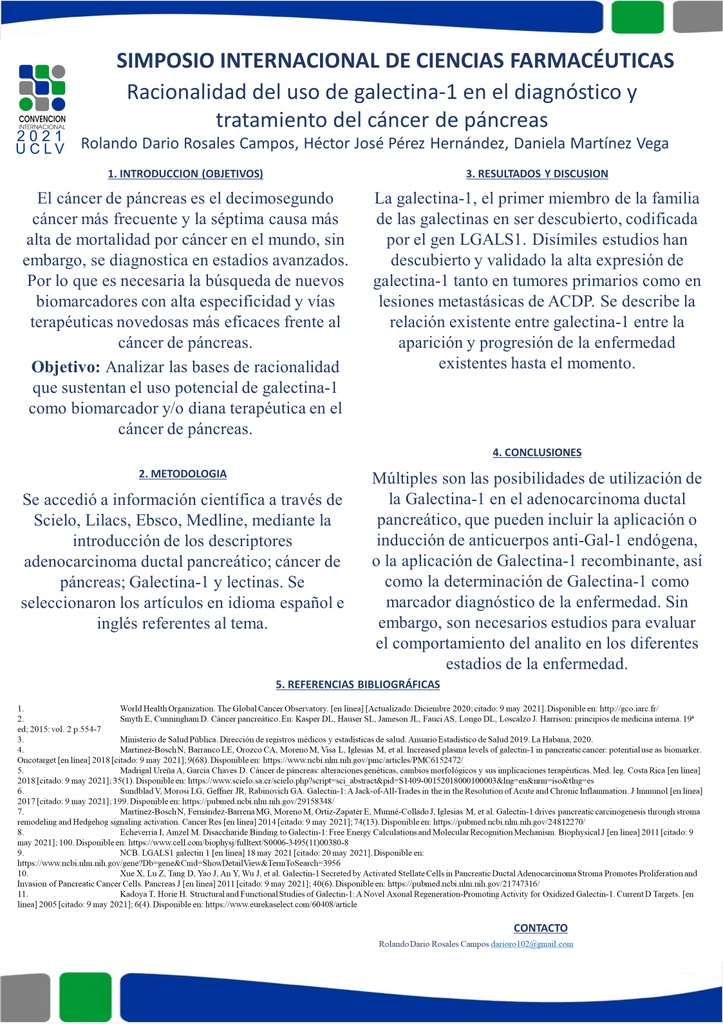Executive Secretary

Simposio Internacional de Ciencias Farmacéuticas
SICF

Resumen
Introducción: El cáncer de páncreas es el decimosegundo cáncer más frecuente y la séptima causa más alta de mortalidad por cáncer en el mundo, sin embargo, se diagnostica en estadios avanzados. Por lo que es necesaria la búsqueda de nuevos biomarcadores con alta especificidad y vías terapéuticas novedosas más eficaces frente al cáncer de páncreas.
Objetivo: Analizar las bases de racionalidad que sustentan el uso potencial de galectina-1 como biomarcador y/o diana terapéutica en el cáncer de páncreas.
Método: Se accedió a información científica a través de Scielo, Lilacs, Ebsco, Medline, mediante la introducción de los descriptores adenocarcinoma ductal pancreático; cáncer de páncreas; Galectina-1 y lectinas. Se seleccionaron los artículos en idioma español e inglés referentes al tema.
Conclusiones: Múltiples son las posibilidades de utilización de la Galectina-1 en el adenocarcinoma ductal pancreático, que pueden incluir la aplicación o inducción de anticuerpos anti-Gal-1 endógena, o la aplicación de Galectina-1 recombinante, así como la determinación de Galectina-1 como marcador diagnóstico de la enfermedad. Sin embargo, son necesarios estudios para evaluar el comportamiento del analito en los diferentes estadios de la enfermedad.
Abstract
Introduction: Pancreatic cancer is the twelfth most frequent cancer and the seventh highest cause of cancer mortality in the world, however, it is diagnosed in advanced stages. For this reason, it is necessary to search for new biomarkers with high specificity and novel therapeutic routes that are more effective against pancreatic cancer.
Objective: To analyze the rationale behind the potential use of galectin-1 as a biomarker and / or therapeutic target in pancreatic cancer.
Method: Scientific information was accessed through Scielo, Lilacs, Ebsco, Medline, by introducing the descriptors pancreatic ductal adenocarcinoma; pancreatic cancer; Galectin-1 and lectins. Articles in Spanish and English referring to the topic were selected.
Results: Galectin-1, the first member of the galectin family to be discovered, encoded by the LGALS1 gene. Dissimilar studies have discovered and validated the high expression of galectin-1 both in primary tumors and in metastatic lesions of ACDP. The relationship between galectin-1 between the onset and progression of the disease existing to date is described.
Conclusions: There are many possibilities for the use of Galectin-1 in pancreatic ductal adenocarcinoma, which may include the application or induction of endogenous anti-Gal-1 antibodies, or the application of recombinant Galectin-1, as well as the determination of Galectin. -1 as a diagnostic marker of the disease. However, studies are necessary to evaluate the behavior of the analyte in the different stages of the disease.
Sobre el ponente

Rolando Darío Rosales Campos

